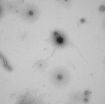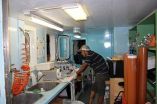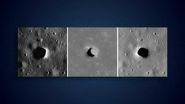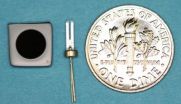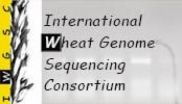(Press-News.org) A fishing expedition of microscopic proportions led by University of Arizona ecologists revealed that the lines between virus types in nature are less blurred than previously thought.
Using lab-cultured bacteria as "bait," a team of scientists led by Matthew Sullivan has sequenced complete and partial genomes of about 10 million viruses from an ocean water sample in a single experiment.
The study, published online on July 14 by the journal Nature, revealed that the genomes of viruses in natural ecosystems fall into more distinct categories than previously thought. This enables scientists to recognize actual populations of viruses in nature for the first time.
"You could count the number of viruses from a soil or water sample in a microscope, but you would have no idea what hosts they infect or what their genomes were like," said Sullivan, an associate professor in the UA's Department of Ecology and Evolutionary Biology and member of the UA's BIO5 Institute. "Our new approach for the first time links those same viruses to their host cells. In doing so, we gain access to viral genomes in a way that opens up a window into the roles these viruses play in nature."
Sullivan's team developed a new approach called viral tagging, which uses cultivated bacterial hosts as "bait" to fish for viruses that infect that host. The scientists then isolate the DNA of those viruses and decipher their sequence.
"Instead of a continuum, we found at least 17 distinct types of viruses in a single sample of Pacific Ocean seawater, including several that are new to science – all associated with the single 'bait' host used in the experiment," Sullivan said.
The research lays the groundwork for a genome-based system of identifying virus populations, which is fundamental for studying the ecology and evolution of viruses in nature.
"Before our study, the prevailing view was that the genome sequences of viruses in a given environment or ecosystem formed a continuum," Sullivan said. "In other words, the lines between different types of viruses appeared blurred, which prevented scientists who wanted to assess the diversity of viruses in the wild from recognizing and counting distinct types of viruses when they sampled for them."
"Microbes are now recognized as drivers of the biogeochemical engines that fuel Earth, and the viruses that infect them control these processes by transferring genes between microbes, killing them in great numbers and reprogramming their metabolisms," explained the first author of the study, Li Deng, a former postdoctoral researcher in Sullivan's lab who now is a research scientist at the Helmholtz Research Center for Environmental Health in Neuherberg, Germany. "Our study for the first time provides the methodology needed to match viruses to their host microbes at scales relevant to nature."
Getting a grip on the diversity of viruses infecting a particular host is critical beyond environmental sciences, Deng said, and has implications for understanding how viruses affect pathogens that cause human disease, which in turn is relevant for vaccine design and antiviral drug therapy.
Sullivan estimates that up to 99 percent of microbes that populate the oceans and drive global processes such as nutrient cycles and climate have not yet been cultivated in the lab, which makes their viruses similarly inaccessible.
"For the first time we can count virus types," he explained, "and we can ask questions like, 'Which virus is more abundant in one environment than another?' Further, the genomic data gives us a way to infer what a virus might do to its bacterial host."
The study benefited from collaboration with Joshua Weitz, an associate professor and theoretical ecologist from the Georgia Institute of Technology who spent time as a visiting researcher in the Sullivan lab.
The new data help scientists like Weitz develop new concepts and theories about how viruses and bacteria interact in nature.
"This new method provides incredibly novel sequence data on viruses linked to a particular host," Weitz explained. "The work is foundational for developing a means to count genome-based populations that serve as starting material for predictive models of how viruses interact with their host microbes. We can now map viral populations with their genomes, providing information about who they are and what they do."
INFORMATION:
The study, "Viral tagging reveals discrete populations in Synechococcus viral genome sequence space," was co-first authored by Cesar Ignacio-Espinoza, a doctoral candidate in molecular and cellular biology; Ann Gregory, a doctoral candidate in soil, water and environmental sciences; and Bonnie Poulos, assistant research scientist in cecology and evolutionary biology. In addition to Weitz, co-authors not at the UA include Georgia and Philip Hugenholtz of the Australian Centre for Ecogenomics at the University of Queensland in Brisbane, Australia.
The research paper is online at http://www.nature.com/nature/journal/vaop/ncurrent/full/nature13459.html
Tiniest catch: University of Arizona scientists' fishing expedition reveals viral diversity in the sea
2014-07-17
ELSE PRESS RELEASES FROM THIS DATE:
Lunar pits could shelter astronauts, reveal details of how 'man in the moon' formed
2014-07-17
VIDEO:
This video shows images from NASA's LRO spacecraft of various lunar pits.
Click here for more information.
While the moon's surface is battered by millions of craters, it also has over 200 holes – steep-walled pits that in some cases might lead to caves that future astronauts could explore and use for shelter, according to new observations from NASA's Lunar Reconnaissance Orbiter (LRO) spacecraft.
The pits range in size from about 5 meters (~5 yards) across to more than ...
Older adults who walk out of necessity are at highest risk for outdoor falls
2014-07-17
Older adults are at a greater danger of falling when walking for utilitarian purposes such as shopping and appointments than when walking for recreation, according to a study from UMass Medical School.
"Older adults have two times the risk of falling while walking out of necessity than walking for recreation, and four times greater risk of injury from a fall on a sidewalk than in a recreational area," said Wenjun Li, PhD, associate professor of medicine in the Division of Preventive and Behavioral Health at UMMS and lead author of the study "Utilitarian Walking, Neighborhood ...
Estimating earthquake frequency and patterns in the Puget Lowland
2014-07-17
Boulder, Colo. - The hazard posed by large earthquakes is difficult to estimate because they often occur hundreds to thousands of years apart. Because written records for the Puget Lowland of northwestern Washington cover less than 170 years, the size and frequency of the largest and oldest earthquakes on the Seattle and Tacoma faults are unknown. Past earthquakes can only be estimated through geologic studies of sediments and landforms that are created when faults break the ground surface.
Along the Cascadia margin, the cities of Seattle and Tacoma occupy the Puget ...
Discovery may make it easier to develop life-saving stem cells
2014-07-17
Not unlike looking for the proverbial needle in a haystack, a team of Michigan State University researchers have found a gene that could be key to the development of stem cells – cells that can potentially save millions of lives by morphing into practically any cell in the body.
The gene, known as ASF1A, was not discovered by the team. However, it is at least one of the genes responsible for the mechanism of cellular reprogramming, a phenomenon that can turn one cell type into another, which is key to the making of stem cells.
In a paper published in the journal Science, ...
Losing sleep over your divorce? Your blood pressure could suffer
2014-07-17
Those who experience persistent sleep problems after a divorce stand to suffer from more than just dark circles. They might also be at risk for potentially harmful increases in blood pressure, a new study finds.
A growing body of research links divorce to significant negative health effects and even early death, yet few studies have looked at why that connection may exist.
Divorce-related sleep troubles may be partly to blame, suggest the authors of a new study to be published in a forthcoming issue of the journal Health Psychology.
"In the initial few months after ...
Choosing cheese
2014-07-17
Go ahead and call Rachel Dutton's research cheesy if you must. As far as she's concerned, it's anything but an insult.
A Bauer Fellow at the Faculty of Arts and Sciences' Center for Systems Biology, Dutton and her lab study cheese – or more precisely – the bacteria and fungi that live on cheese, in an effort to better understand how microbial communities form.
After studying 137 varieties of cheese collected in 10 different countries, Dutton has been able to identify three general types of microbial communities that live on cheese, opening the door to using each as ...
Future electronics may depend on lasers, not quartz
2014-07-17
Nearly all electronics require devices called oscillators that create precise frequencies—frequencies used to keep time in wristwatches or to transmit reliable signals to radios. For nearly 100 years, these oscillators have relied upon quartz crystals to provide a frequency reference, much like a tuning fork is used as a reference to tune a piano. However, future high-end navigation systems, radar systems, and even possibly tomorrow's consumer electronics will require references beyond the performance of quartz.
Now, researchers in the laboratory of Kerry Vahala, the ...
Exploiting gastric vulnerability
2014-07-17
Helicobacter pylori infection promotes stomach ulcers and cancer. How H. pylori initially interacts with and irritates gastric tissue is not well understood. An article published on July 17th in PLOS Pathogens now describes that H. pylori rapidly identifies and colonizes sites of minor injuries in the stomach, almost immediately interferes with healing at those injury sites, and so promotes sustained gastric damage.
Smoking, alcohol, excessive salt intake, and non-steroidal anti-inflammatory drugs cause damage to the tissue lining the stomach, and are associated with ...
Genetic blueprint of bread wheat genome unveiled
2014-07-17
This news release is available in French, Japanese, and German.
The genetic blueprint is an invaluable resource to plant science researchers and breeders. For the first time, they have at their disposal a set of tools enabling them to rapidly locate specific genes on individual wheat chromosomes throughout the genome. Jorge Dubcovsky, Professor at the University of California Davis, USA, says that these results "have been a fantastic resource for our laboratory. The development of genome specific primers, which used to take several weeks of work, can now be done ...
New study shows how existing cropland could feed billions more
2014-07-17
MINNEAPOLIS / ST. PAUL (July 18, 2014) Feeding a growing human population without increasing stresses on Earth's strained land and water resources may seem like an impossible challenge. But according to a new report by researchers at the University of Minnesota's Institute on the Environment, focusing efforts to improve food systems on a few specific regions, crops and actions could make it possible to both meet the basic needs of 3 billion more people and decrease agriculture's environmental footprint.
The report, published today in Science, focuses on 17 key crops ...
